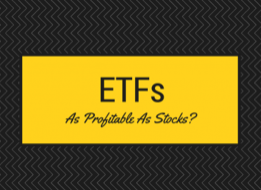
I read with interest Josh Brown’s piece this last Wednesday regarding Ritholtz’s decision to get out of the “single-stock” business. The topic is a conversation that I have had with many friends in the Asset Management business over the last few years. Many of them stopped buying single stocks for clients years ago and went the ETFs route. Why? Common sense and career preservation. Nobody wants to have the conversation with the Client when a stock they are holding blows up or is mired in some type of scandal as well as all of the other decision making headaches that go with managing multiple portfolios with different entry points. There is a common misconception among some people that one can’t make as much money in ETFs as in stocks. I ran some numbers and by using correct volatility based position sizing, it shed some light on the matter.
Below is a piece that I wrote for Members of my website on September 22 of 2017:
A statement I often hear from traders is: “You can’t make as much money in ETFs as you can in stocks”.
Let’s analyze the numbers. We will use one of my favorite high beta sectors, Steel, to put the numbers to the test. We are going to analyze the performance of U.S. Steel, X, vs the Van Eck Market Vectors Steel ETF, SLX. We will use closing data, price and ATR(14), from December 31, 2015, end of year, a fairly standard starting point as our entry data points and the highest closing price of this last steel uptrend as our exit point.
From the close on December 31, 2015 to the closing high on February 21, 2017, U.S Steel gained 430%. SLX also peaked on February 21, 2017 on a closing basis, and in the same time period, the Steel ETF gained 134%. It seems obvious that U.S. Steel was the more profitable trade…but was it?
As we have discussed in our prior post, “Understanding Correct Position Sizing” from 9/22/17, like many systematic traders, we use volatility based position sizing to help manage risk, manage positions and size our trades. The premise is that more volatile positions, based on their daily volatility range, are allocated less capital, to offset the risk from increased volatility. The top priority of any experienced trader is to manage risk first and foremost and protect downside. Volatility based position sizing is a great strategy to help accomplish this.
The illustration below shows that U.S. Steel had a very wide range, ATR (14), of 7.91% on 12/31/15. SLX had an ATR(14) range of 2.43%, or only 31% as volatile.
As a result of the enhanced volatility, the U.S Steel position was allocated a $3,155 position size in our example. SLX was allocated $10,248. Both positions had an open risk to stop loss of .50%, or $500, our pre-determined risk range in this example.
Although U.S. Steel rose in value considerably more on a percentage basis, (430% vs 134%), the SLX ETF actually netted a higher total dollar profit when each position was closed out, ($13,790 vs $13,597). The ETF position also avoids the single stock event risk that is inherent in any single stock position, vs a basket of stocks (ETF). To answer our opening question, yes, ETFs can be as profitable as stocks, and in many cases offer better risk adjusted returns, and greater diversification benefits.
Assumptions
Hypo: $100,000
Risk: 0.50% per position
Stop Loss: 2 x ATR(14)
U.S. Steel
Van Eck Steel ETF
X
SLX
Closing Price 12/31/15
7.83
19.30
ATR
.62
.47
Daily Range
7.91%
2.43%
2ATR Stop Loss
1.24
.94
Risk %
.50%
.50%
Risk $
$500
$500
Position Size Units
403
531
Position Size $
3,155
10,248
Closing High Date
2/21/17
2/21/17
Closing High $
41.57
45.27
Closing Position Size
$16,752
$24,038.37
P/L %
+430%
+134%
P/L $
$13,597
$13,790
